Tritonia gladiolaris
Tritonia gladiolaris (Lam.) Goldblatt & J.C.Manning
Family: Iridaceae
Common names: pencilled tritonia, yellow tritonia, lined tritonia (Eng.); bergkatjietee (Afr.); khahla-e-nye-nyane (siSwati); isidwi esimpofu (isiZulu).
Introduction
Tritonia gladiolaris is a striking South African wildflower with slender, sword-like leaves and cream to pale yellow, funnel-shaped flowers, known for transforming grasslands in spring, attracting pollinators, thriving on rocky slopes, holding traditional medicinal value for treating infant stomach issues and navel infections, and bearing a complex botanical history with many past synonyms.

Description
Description
Tritonia gladiolaris is a deciduous, bulbous perennial, usually 200-500 mm tall, that can reach heights of up to 800 mm. It has a spherical corm, typically around 10-20 mm in diameter, that is covered by fine, fibrous tunics. The stem can be simple or branched. The plant produces erect to spreading, narrowly lanceolate leaves, measuring 150-300 mm long and 7-10 mm wide, with clearly visible mid- and marginal veins. The brightly coloured flowers appear from late winter to spring (August to November), in a spike of 4-12 short tubed flowers with dry papery brown bracts. They are not scented, cream coloured to pale yellow, or tinted with pale apricot near the tips, have dark veins, are funnel-shaped, and about 35 × 25 mm in size. The blooms are slightly asymmetrical and flare outward, making them highly attractive to bees and other pollinators. After flowering (mainly from September to October), the plant produces elongated seed capsules measuring approximately 8 mm in length.
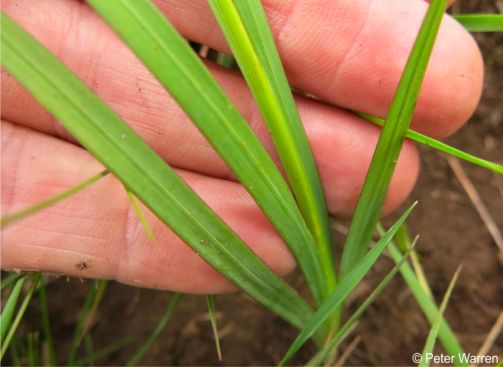
Conservation Status
Status
Tritonia gladiolaris is classified as Least Concern (LC) by the Red List of South African Plants, which means that it is not facing the threat of extinction at present. This status indicates that the plant has a healthy and stable population in its natural environment and is found in good numbers across a broad geographical area. Currently, there are no serious threats causing a rapid decline in its numbers.Because of this, the species does not meet the criteria for being listed under more severe conservation categories such as Vulnerable, Endangered, or Critically Endangered.

Distribution and habitat
Distribution description
Tritonia gladiolaris grows in stony grassland, from near sea level to the high Drakensberg, typically on dolerite or sandstone soils, across a wide area from the southeastern and eastern South Africa to Mpumalanga. It also occurs in Lesotho and therefore is not a South African endemic species. It occurs widely in several South African provinces, its natural range stretching from Mossel Bay in the Western Cape through Eastern Cape, KwaZulu-Natal and the eastern Free State, and as far north as Wakkerstroom in Mpumalanga.
This species thrives at various altitudes from coastal lowlands to high mountain areas like the Drakensberg. It prefers summer rainfall regions and is able to withstand frost by dying back in winter and resprouting from its underground corm. These conditions indicate that the plant is well adapted to cool and warm climates with moderate rainfall and well-drained soils.
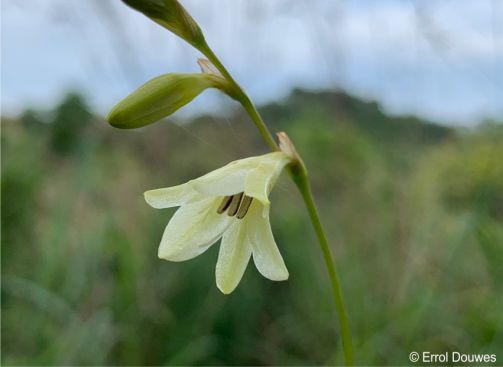
Derivation of name and historical aspects
History
The genus Tritonia was named by the English botanist, J.B. Ker Gawler, in 1802. The word triton is Latin meaning weather vane. Ker Gawler named this genus triton due to how the arrangement of the stamens differs among the species. The species name gladiolaris means ‘resembling gladiolus’, and could refer to the genus Gladiolus, describing how this species looks limilar to some gladioli, or the Latin word gladiolus, meaning ‘a small sword’, referring to the narrow, sword-like leaves of these species.
This species was first described as Ixia gladiolaris by Lamarck in 1789. Its current identity is described by P. Goldblatt and J.C.Manning as Tritonia gladiolaris, published in Bothalia 36 in 2006. There has been a lot of taxonomic work done on this species and it has been described under many names, even in different genera, by different botanists over the years. This taxonomic work has led to this species having a lot of synonyms, namely: Gladiolus lineatus Salisb., Ixia gladiolaris Lam., Montbretia lineata (Salisb.) Baker. The most recent taxonomic work on Tritonia gladiolaris was done by Goldblatt & Manning published in Strelitzia 42 in 2020. They added the following as synonyms to Tritonia gladiolaris: Ixia striata, Ixia squalida var. stricta, Gladiolus venosus, Ixia reticulata, Tritonia tristis, Tritonia kraussii, Tritonia flavida, and Tritonia lineata var. parvifolia. Thus all the plants described under these names are now considered to be the same variable species, Tritonia gladiolaris. Many of the synonyms refer to the dark veins on the tepals, lineata means lined, striata means striped, venosus means veiny and reticulata means netted.
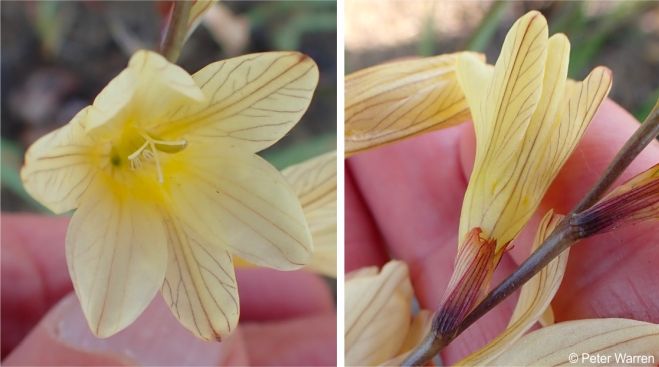
Ecology
Ecology
Tritonia gladiolaris is probably pollinated by long-tongued bees foraging for nectar. Once the flowers have been pollinated, the ovary develops into a capsule. Over time, the capsule dries out, cracks and opens when mature and the ripe seeds are dispersed when the wind shakes the capsules.
Just like other Tritonia species, Tritonia gladiolaris is also deciduous. Meaning in order to survive the cold winter months, the above the ground parts die back, the plant lies dormant throughout winter and resprouts again in spring when the temperatures rise and the rains return.
Uses
Use
Tritonia gladiolaris is used in traditional medicine to heal infections on the navel of new born babies and to treat stomach complaints in babies. It also makes a beautiful a pot plant. For it to have an effect in the garden, it is recommended to plant many of them very closely together, because they are solitary plants.
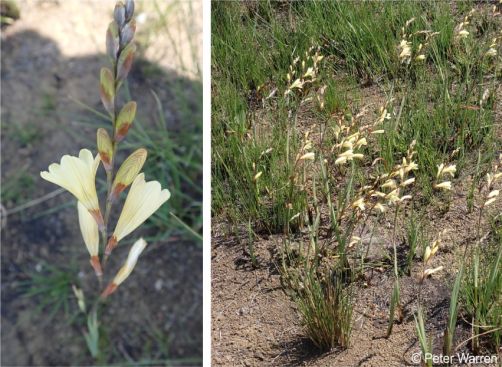
Growing Tritonia gladiolaris
Grow
Tritonia gladiolaris grows in both full sun and semi-shade. It does well when planted in pots and directly into the ground, provided that the soil is well-drained and humus-rich. Good drainage plays a crucial role in preventing the corms from rotting. Plant the small corms very closely together so that they make a show when in flower. Water regularly in summer and heavily reduce watering when the leaves start to die back and stop watering throughout winter while they are dormant.
The Pencilled Tritonia is very easy to propagate by seeds. The ideal time to sow the seeds is during the growing season, between spring and summer. Sow seeds in a 50:50 mix of compost and sieved potting soil or river sand or silica sand, and cover with a thin layer, 3-5mm, of the sowing medium.
Some corms and bulbous plants are the porcupines favourite, so keep them out of the porcupine’s reach. Although the corms are small, mass planting might invite porcupines.
References
- Bowers-Winters, G. 2023-Sep. Observation of Tritonia gladiolaris, Ugu, KwaZulu-Natal. iNaturalist. Online. https://www.inaturalist.org/observations/183528962.
- Douwes, E. 2021-Dec. Observation of Tritonia gladiolaris, Umgungundlovu, KwaZulu-Natal. iNaturalist. Online. https://www.inaturalist.org/observations/104811108.
- Foden, W., Potter, L. & Patel, T. 2021. Tritonia gladiolaris (Lam.) Goldblatt & J.C.Manning. National Assessment: Red List of South African Plants. https://redlist.sanbi.org/species.php?species=1537-76.
- Goldblatt, P. & Manning, J. 2000. Cape Plants. A conspectus of the Cape flora of South Africa. Strelitzia 9. National Botanical Institute, Pretoria & Missouri Botanical Garden, Missouri.
- Goldblatt, P. & Manning, J.C. 2020. Iridaceae of southern Africa. Strelitzia 42. South African National Biodiversity Institute, Pretoria.
- Hutchings, A., Scott, A.H., Lewis, G. & Cunningham, A.B. 1996. Zulu medicinal plants: an inventory. University of Natal Press, Pietermaritzburg.
- Jackson, W.P.U. 1990. Origins and meanings of names of South African plant genera. University of Cape Town Printing Department, Cape Town.
- Manning, J. C. & Goldblatt, P. 2011. Notes on African Plants, Iridaceae; Tritonia lineata var. parvifolia included in T. gladiolaris. Bothalia 41(1): 171-175.
- Pooley, E. 1998. A field guide to wild flowers of Kwazulu-Natal and the eastern region. Natal Flora Publications Trust, Durban.
- Warren, P. 2012-Dec. Observation of Tritonia gladiolaris, Table Mountain, KwaZulu-Natal. iNaturalist. Online. https://www.inaturalist.org/observations/10847610.
- Warren, P. 2022-Sep. Observation of Tritonia gladiolaris, Indlovu, KwaZulu-Natal. iNaturalist. Online. https://www.inaturalist.org/observations/134411767.
Credits
Dineo Dibakwane and Anabo Ngomani
Walter Sisulu National Botanical Garden
August 2025
Acknowledgements: the authors thank Peter Warren, Errol Douwes and Gail Bowers-Winters for the photos.
Plant Attributes:
Plant Type: Bulb
SA Distribution: Eastern Cape, Free State, KwaZulu-Natal, Mpumalanga, Western Cape
Soil type: Sandy, Loam
Flowering season: Spring, Early Summer
PH: Acid, Neutral
Flower colour: Brown, Cream, Yellow
Aspect: Full Sun, Morning Sun (Semi Shade), Afternoon Sun (Semi Shade)
Gardening skill: Easy
Special Features:
Horticultural zones
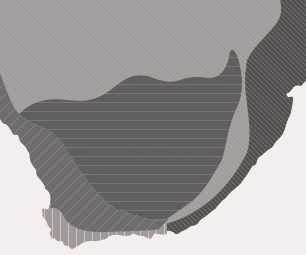








Rate this article
Article well written and informative
Rate this plant
Is this an interesting plant?
Login to add your Comment
Back to topNot registered yet? Click here to register.